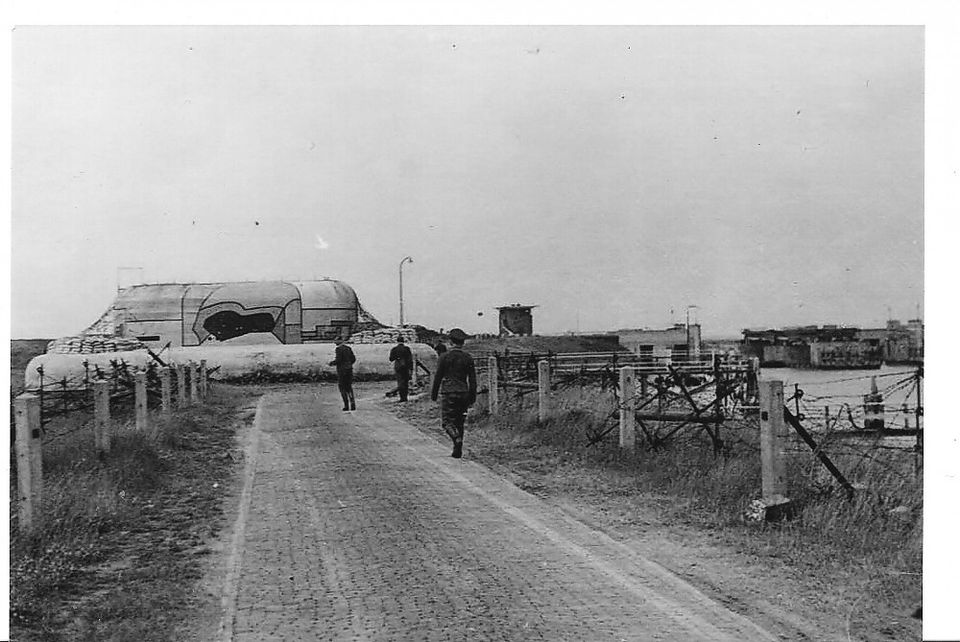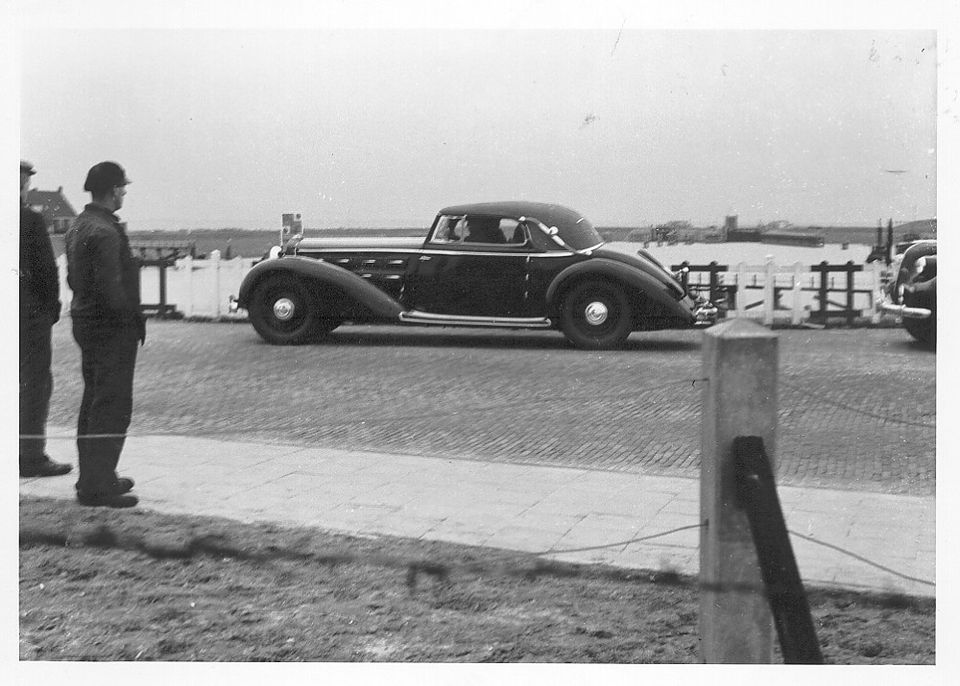Short-lived heroic role for Kornwerderzand
Reading time: less than 6 minutes
On 11 May 1940, German troops emerged on the Afsluitdijk. The first obstacle they faced, Stelling Wons, proved to be useless. The Germans were soon able to advance to the head of the Afsluitdijk. There they met with hostile fire and were forced to retreat. At first, it seemed only for a matter of time because the light artillery from the Kornwerderzand casemates would eventually be no match for the Germans' heavy artillery. But help was on the way. Thanks to the support of gun ship Hr. Ms. Johan Maurits van Nassau, Kornwerderzand would play a brief heroic role.
The fortifications at Den Oever and Kornwerderzand were constructed between 1932 and 1936, immediately after completion of the Afsluitdijk. This occurred under pressure from the army command at the time, who foresaw two new problems with the intended construction of the dike. First and foremost, the dike would form a new access route to the Vesting Holland, which was connected to the northern front of the Stelling Amsterdam on its northern side. The route to marine harbour Den Helder would also be wide open.
Great strategic importance
But the intention to build two basin lock complexes into the Afsluitdijk, one at Den Oever and one at Kornwerderzand, troubled the army command even more. These were intended to regulate the water level in the IJsselmeer and would also be of great importance to the inundations - the strategic flooding of the New Dutch Waterline and the Grebbe Line. However, it would be catastrophic if the basin locks fell into the wrong hands.

Asparagus
17 heavy casemates were constructed around the lock complex of Kornwerderzand. The two eastern lines would be able to fire over the head of the Afsluitdijk while the line west of the locks was aimed at Breezanddijk. On the east side, the fortification was closed off with a double row of steel H-beams, meant to deter armoured vehicles. The so-called 'Asparaguses'.
German and defeated Dutch soldiers between the barricades after the surrender.

Mobilisation
During the mobilisation on 28 August 1939, Stelling Wons was constructed and the Kornwerderzand casemates were manned. There was still a wooden work hotel near the casemates that had been used during the construction of the Afsluitdijk and lock complex. It was burned down as a precaution in May 1940. The homes of the Water Management personnel were blown up to provide the Dutch army with a clean line of fire from the casemates.
During the first days of the war, the crew at Stelling Wons could already see the retreating Dutch units while the vanguard of the German troops kept a close eye on them. On 11 May 1940, the first German Kavallerie-Division, led by Generalmajor Feldt, reached the head of the Afsluitdijk. Once there, Stelling Wons, a weak, improvised defence line around the entrance to the Afsluitdijk, had to be conquered. Fields were flooded and artillery was installed in the hastily constructed clay casemates, hardly even worthy of the name. The fortification was quickly defeated but most of the Dutch soldiers were able to escape to Medemblik and Enkhuizen.
Germans under fire
To further explore the head of the Afsluitdijk, the Germans proceeded towards Kornwerderzand, where they were met with enemy fire. They retreated. This seemed to only be a temporary setback, as the light artillery at Kornwerderzand would never be able to stand up to the heavy German artillery. To meet their need for heavier cannons, the help of gun ship Hr. Ms. Johan Maurits van Nassau was called in. On 13 May 1940, the war ship sailed onto the Wadden Sea from Den Helder, to lay fire on the head of the Afsluitdijk. Its position was precarious because the narrow channel 'De Dove Balg' did not leave much room for manoeuvring and German fighters could show up at any moment.
The Johan Maurits was not able to hold its position for long, yet it still managed to silence the German artillery by firing 91 shots from an 18.5-kilometre distance. This was on the morning of 14 May. The ship then set sail for Den Helder to continue its journey to England from there. Unfortunately, German bombers sank the gun ship outside the coast of Callantsoog, claiming the lives of 17 crew members.
Human shield
That same day, 14 May 1940, German soldiers rounded up the citizens of Cornwerd in the local church. Presumably, their intention was to use them as a human shield during a subsequent attack. But that attack never happened. The Netherlands had already lost the war. The Dutch army surrendered after the devastating bombing of Amsterdam, which also took place on 14 May in the early afternoon. News of the surrender hit the Dutch soldiers, who had maintained their position at Kornwerderzand, very hard. They had prepared for a long siege and were teeming with self-confidence. But their superior, Captain Boers, commander of Stelling Kornwerderzand, confirmed the surrender by walking towards Wons waving a white flag. Not long after, the German troops advanced over the Afsluitdijk towards North Holland.
The occupation
German troops occupied the fortification during the war. Although no direct attack from the sea was expected, they reinforced the fortification with three bunkers from the 600 series. As far as is known, these were added to the defence line in the autumn of 1942 to fortify the western front. Two bunkers were faced towards Breezanddijk while the third was meant to lay fire over the head of the Afsluitdijk. Two open constructions for anti-aircraft artillery and three crew quarters were also added to Stelling Kornwerderzand. Foxholes were dug and the road barricades were reinforced with so-called dragon's teeth. The homes of Water Management personnel were rebuilt during the German occupation.
The German army fortified Stelling Wons and concrete rolling blocks were used to close off the access roads to the Afsluitdijk. Around the barricades, shrapnel-free quarters and platforms for anti-aircraft artillery were built. One of the bunkers near Zürich was equipped with an outlook tower to keep the Wadden Sea under surveillance.
Liberation
After Sneek was liberated on 15 April 1945, the Canadian troops advanced towards the Afsluitdijk. Fighting there was fierce, just as it was in 1940. And once again, Kornwerderzand proved to be a difficult obstacle to conquer. There was heavy fighting at Stelling Wons on 18 April. German defenders perforated three Canadian armoured vehicles using anti-aircraft artillery. Five crew members were killed and three more were wounded. But in the end, the Canadian fire power proved to be superior and the Germans surrendered. Stelling Wons fell, but the Canadians were still not able to cross the Afsluitdijk. They had to wait until 5 May 1945, the day German troops in the west of the Netherlands surrendered, to pass Stelling Kornwerderzand.
In the Casemates Museum, you will learn all about the construction of the Afsluitdijk, the lock complex and, of course, the casemates. Through stories and expositions, the museum covers the period from construction to the Cold War. Watch a film with interviews with veterans who served in Kornwerderzand in 1940 and visit the expositions in the various casemates.
Visit Kornwerderzand


